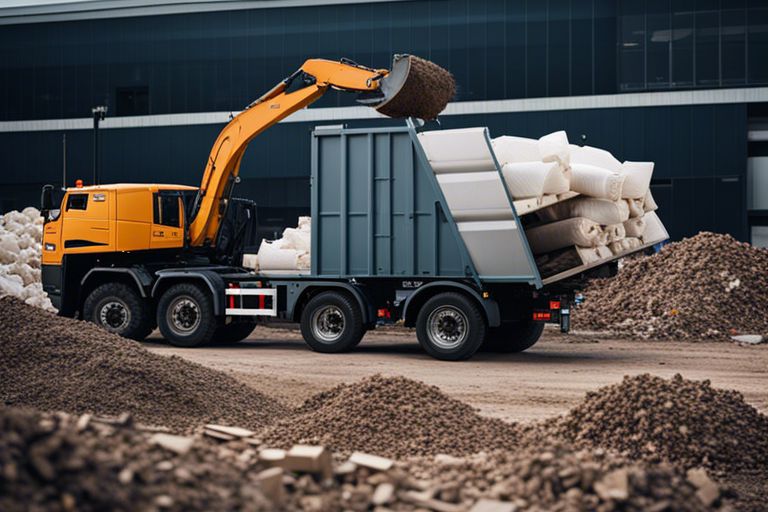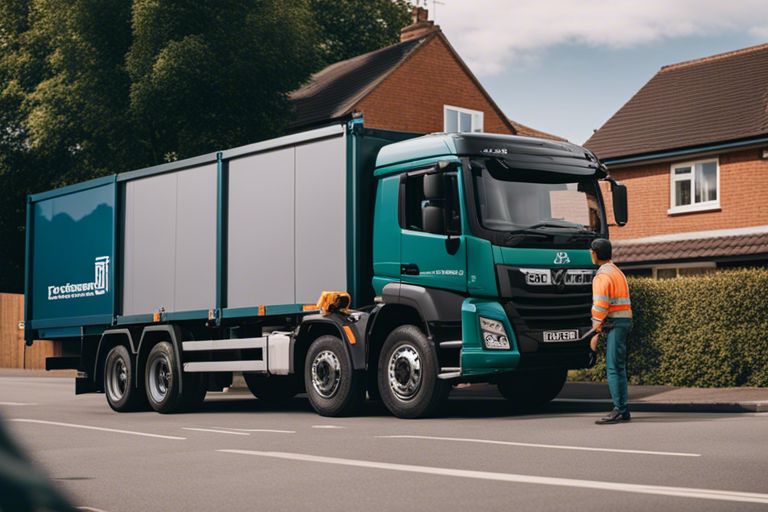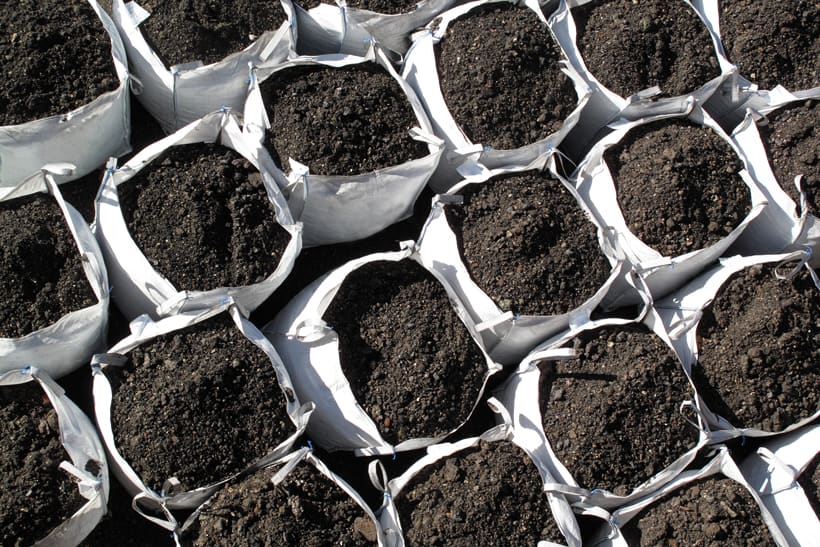Obfuscate the misconception that demolition is always harmful to the environment. In reality, the way in which buildings are demolished can have a significant impact on the surrounding environment. Proper planning and the use of environmentally-friendly practices can mitigate the negative effects of demolition and promote sustainability in the construction industry. From reducing waste and emissions to implementing recycling and repurposing materials, there are crucial steps that can be taken to ensure that demolition practices are carried out in an eco-friendly manner.
For more detailed information about sustainable construction and demolition practices, you can check out this Tips for Sustainable Construction and Demolition Practices blog post.
Key Takeaways:
- Proper waste management: It is essential to have a detailed plan for sorting and disposing of waste material to minimise environmental impact during demolition.
- Use of eco-friendly equipment: Employing machinery and tools that are energy-efficient and produce minimal emissions can significantly reduce the environmental footprint of demolition practices.
- Compliance with regulations: Adhering to local and national environmental regulations is crucial to ensure that the demolition process is environmentally responsible and sustainable.
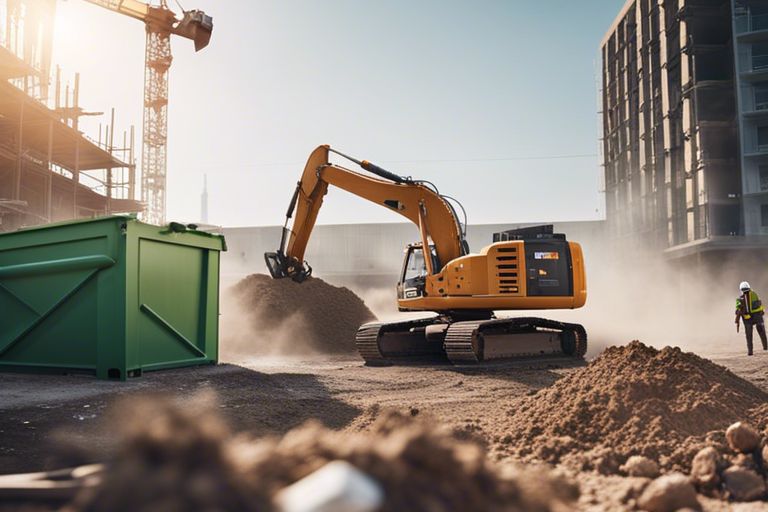
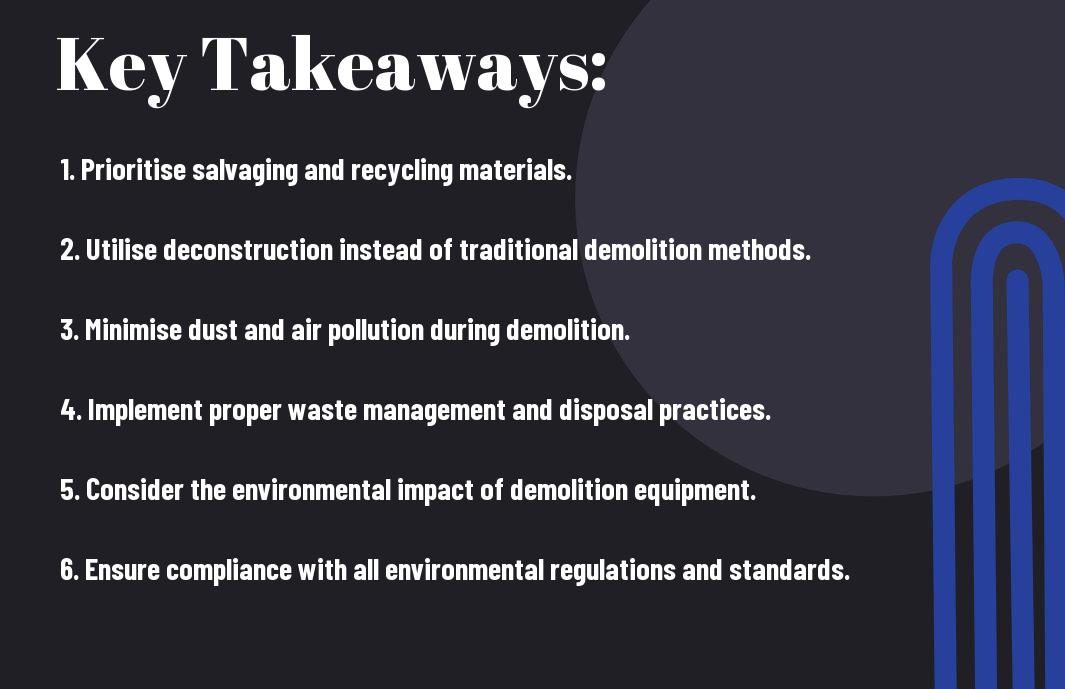
Planning and Environmental Assessments
In the initial stages of any demolition project, it is crucial to understand the environmental impact of the proposed work. This involves conducting thorough assessments and creating a well-informed plan that prioritises eco-conscious practices. By considering environmental factors from the outset, we can ensure that our demolition activities do not harm the surrounding ecosystem.
Conducting Preliminary Environmental Assessments
Prior to commencing any demolition work, it is essential to conduct preliminary environmental assessments to identify any potential risks or challenges. This involves evaluating the site for any endangered species, sensitive habitats, or contamination issues. By thoroughly assessing the environment, we can proactively address any concerns and develop strategies to mitigate negative impacts.
Creating an Eco-conscious Demolition Plan
Once the preliminary assessments have been completed, the next step is to create an eco-conscious demolition plan. This strategic plan outlines the specific measures and techniques that will be employed to minimise environmental damage during the demolition process. By incorporating eco-friendly practices, such as recycling materials and reducing waste, we can ensure that our demolition activities are conducted in a sustainable manner.
By prioritising environmentally-friendly demolition practices, we can positively contribute to the preservation of natural habitats and the overall well-being of the environment. Through careful planning and proactive measures, we can demonstrate a commitment to protecting the environment while carrying out necessary demolition work.
Material Management Strategies
In the process of environmentally-friendly demolition, it is crucial to have effective material management strategies in place. These strategies are aimed at minimising waste, salvaging and reusing building materials, and ensuring proper disposal of any remaining waste.
Salvaging and Reusing Building Materials
One of the essential steps in environmentally-friendly demolition practices is the salvaging and reusing of building materials. This process involves carefully dismantling structures to retrieve materials such as bricks, timber, metals, and other valuable components. By salvaging and reusing these materials, we can reduce the amount of waste generated and conserve valuable resources. It also reduces the demand for new materials and lowers the environmental impact of demolition.
Recycling and Proper Disposal of Waste
Another important aspect of material management in environmentally-friendly demolition practices is the recycling and proper disposal of waste. Materials such as concrete, asphalt, and other construction debris can be recycled to create new products or used as alternative materials for other projects. Proper disposal of hazardous waste, such as asbestos and lead-based paints, is also crucial to prevent environmental contamination and protect public health.
It is important to work with certified recycling facilities and licensed waste disposal companies to ensure that all waste is handled and disposed of properly, in compliance with environmental regulations and standards.

Techniques for Minimizing Environmental Impact
When it comes to environmentally-friendly demolition practices, there are several techniques that can be employed to minimise the impact on the surrounding environment. Selective deconstruction methods and low-impact demolition technology are two key approaches that can significantly reduce the environmental footprint of demolition projects.
Selective Deconstruction Methods
Selective deconstruction involves carefully dismantling a structure in order to salvage and reuse materials, rather than simply demolishing it and sending everything to landfill. By using this method, valuable resources such as timber, brick, and metal can be saved from ending up as waste, reducing the demand for new materials and the associated environmental impact. This approach also allows for the identification and proper disposal of any hazardous materials, preventing potential harm to the environment.
Low-Impact Demolition Technology
Low-impact demolition technology utilises innovative equipment and techniques to carry out demolition activities with minimal disturbance to the environment. This may include the use of advanced machinery that produces lower levels of noise and vibration, as well as dust suppression systems to control airborne particles. By adopting these technologies, the negative impact on air quality, surrounding ecosystems, and local communities can be significantly reduced.
By implementing low-impact demolition technology, contractors can demonstrate their commitment to sustainable practices and gain a competitive edge in the industry. This approach also enhances safety for workers and surrounding communities, as well as minimising disruption to neighbouring properties.
Legal and Compliance Considerations
Understanding Local and Federal Regulations
Before carrying out any demolition work, it is crucial to have a thorough understanding of the local and federal regulations governing demolition practices. Local authorities often have specific regulations in place to protect the environment, public health, and safety. Similarly, federal regulations, such as the Environmental Protection Act, dictate strict guidelines for demolition activities. Failing to comply with these regulations can result in severe penalties and legal repercussions.
It is essential to consult with legal experts and regulatory authorities to ensure full compliance with these regulations. This may involve obtaining permits, conducting environmental impact assessments, and adhering to specific waste disposal guidelines. Having a comprehensive understanding of these regulations is fundamental to carrying out environmentally-friendly demolitions.
Obtaining Necessary Permits and Documentation
Obtaining the necessary permits and documentation is a critical step in legally and responsibly conducting demolition activities. This involves obtaining permits from local authorities, submitting environmental impact assessments, and obtaining clearance from relevant government agencies. Without the appropriate permits and documentation, demolitions can be halted, and hefty fines may be imposed.
It is essential to work closely with regulatory authorities from the outset to ensure all necessary permits and documentation are in place before commencing demolition work. Adhering to these legal requirements is imperative to ensure the safe and environmentally-friendly completion of demolition projects.
Ensuring compliance with legal and regulatory requirements is crucial to avoiding any disruptions or penalties during the demolition process. It is important to understand the potential consequences of non-compliance and take the necessary steps to adhere to the relevant regulations.
Case Studies and Best Practices
In this chapter, we will explore case studies and best practices in environmentally-friendly demolition. These examples of successful green demolitions will provide valuable insights and data on the effectiveness of sustainable practices.
- Eco-Friendly House Demolition — 8 Sustainable Practices…
- Green Demolition Project in Urban Renewal Area
- Industrial Site Demolition with 90% Materials Recycling Rate
Examples of Successful Green Demolitions
These examples demonstrate the positive impact of implementing environmentally-friendly demolition practices. The data shows significant reductions in waste and environmental footprint, resulting in cost savings and community benefits.
Through innovative approaches and collaboration with stakeholders, these case studies have set a benchmark for green demolitions in various settings.
Lessons Learned and Recommendations
Based on the case studies, it is evident that successful environmentally-friendly demolitions require strategic planning, comprehensive assessments, and strong partnerships with the recycling industry and local communities.
It is important to prioritise the health and safety of workers and the local environment throughout the demolition process. Adhering to regulations and utilising advanced technology are crucial in achieving successful outcomes.
Further research and knowledge-sharing are recommended to continue improving environmentally-friendly demolition practices and their wide-scale implementation.
Essential Steps for Environmentally-friendly Demolition Practices
In conclusion, it is crucial for construction companies and demolition teams to adopt environmentally-friendly practices in their work. By following essential steps such as conducting thorough material assessments, salvaging reusable materials, properly disposing of hazardous waste, and using sustainable demolition techniques, we can significantly reduce the negative impact of demolition on the environment. It is our responsibility to ensure that our actions do not further contribute to environmental degradation, and by implementing these practices, we can make a positive difference in the construction industry. Ultimately, by prioritising sustainability in demolition practices, we can not only lessen our environmental footprint, but also contribute to the overall health and well-being of the planet for future generations. This is an essential aspect of responsible and ethical construction work, and it is imperative that we continue to strive for environmentally-friendly solutions in our industry.
FAQ
Q: What are the essential steps for environmentally-friendly demolition practices?
A: The essential steps for environmentally-friendly demolition practices involve thorough planning, salvaging and recycling materials, proper hazardous waste disposal, dust and noise control measures, and restoration of the site.
Q: Why is thorough planning important in environmentally-friendly demolition?
A: Thorough planning is crucial as it allows for the identification of recyclable materials, hazardous substances, and the development of a strategy to minimise environmental impact.
Q: How can materials be salvaged and recycled during demolition?
A: Materials such as metal, wood, concrete, and masonry can be salvaged and recycled by careful deconstruction and sorting processes, leading to reduced waste and resource conservation.
Q: What measures should be taken for proper hazardous waste disposal during demolition?
A: Hazardous waste, such as asbestos, lead-based paint, and other toxic materials, should be safely removed and disposed of in accordance with environmental regulations to prevent contamination of the surrounding area.
Q: What are effective dust and noise control measures during demolition?
A: Effective dust and noise control measures include the use of water to suppress dust, enclosing the work area with barriers, and scheduling noisy activities at times when they will cause minimal disruption.


